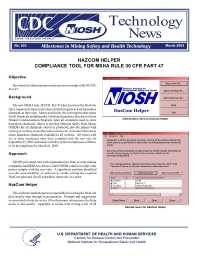Mining Publication: Technology News 503 - HAZCOM Helper Compliance Tool for MSHA Rule 30 CFR Part 47
Original creation date: March 2003
The new MSHA rule, 30 CFR, Part 47 (also known as the HazCom rule), requires all mines to develop a written program to track hazardous chemicals at their sites. More specifically, the rule requires that mines list all chemicals and determine which are hazardous; develop a written Hazard Communication Program; label all containers used to store hazardous chemicals; obtain or develop Material Safety Data Sheets (MSDS) for all chemicals stored or produced; provide miners with training in working around hazardous chemicals; and make information about hazardous chemicals available to all workers. All mines with six or more employees must have complied with the new rule by September 23, 2002, and mines with five or fewer employees will have to be in compliance by March 21,2003. NIOSH personnel met with representatives from several mining companies and MSHA to discuss what NIOSH could do to help companies comply with the new rule. A significant problem identified was the nonavailability of software to enable writing the required HazCom plan and list all hazardous chemicals at a mine. This software leads the person responsible for writing the HazCom plan step-by-step through its preparation. Prompts and suggestions are provided to help the writer fill in the proper information; the Help menu is also useful. Appendix A assists with writing a list of all hazardous chemicals at a site. The program can be saved and recalled at any time so it can be updated whenever necessary.
Authors: DF Scott
Technology News - March 2003
NIOSHTIC2 Number: 20022394
Spokane, WA: U.S. Department of Health and Human Services, Public Health Service, Centers for Disease Control and Prevention, National Institute for Occupational Safety and Health, Technology News 503, 2003 Mar; :1-2
See Also
- Assessing Noise and Dust: NIOSH and Vulcan Materials Co. Team Up to Test How Well Helmet-CAM Technology Measures Miner Exposure Levels
- A Case Study in Applied Social Marketing: Developing an Occupational Safety and Health Product
- EVADE 2.0
- EVADE Software - 2.0
- Technology News 510 - HazCom Helper - OSHA Version: Compliance Tool For OSHA Rule 29 CFR 1910.1200
- Page last reviewed: 9/21/2012
- Page last updated: 9/21/2012
- Content source: National Institute for Occupational Safety and Health, Mining Program


 ShareCompartir
ShareCompartir
